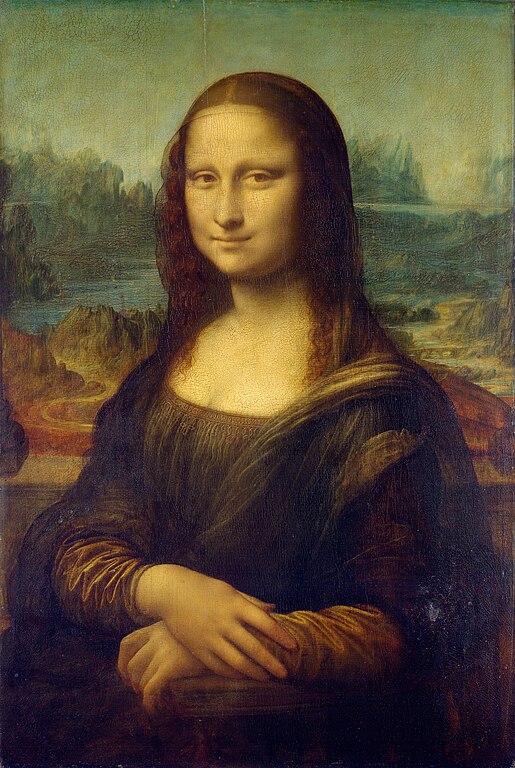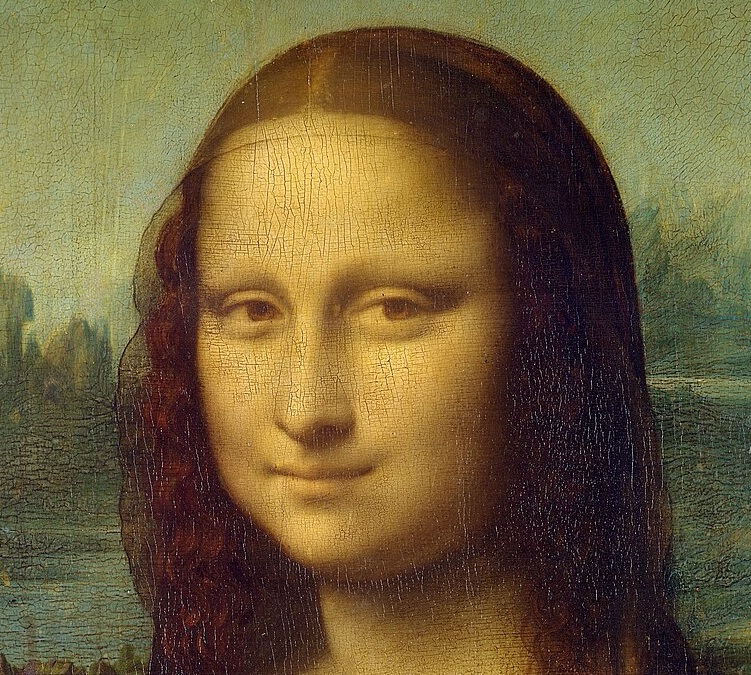
Title: Mona Lisa
Artist: Leonardo da Vinci
Date Painted: c. 1503-1506
Medium: Oil on Poplar Panel
Dimensions: 77cm x 53cm
Location: Louvre, Paris
Summary
The “Mona Lisa,” painted by Leonardo da Vinci in the early 16th century, is arguably the most famous and celebrated artwork in the world. Created between 1503 and 1506, and possibly continuing until 1517, the painting is a portrait of Lisa Gherardini, the wife of Florentine merchant Francesco del Giocondo, hence the alternative Italian name, “La Gioconda.” The French name, “La Joconde,” reflects the same.
Composition and Technique: Da Vinci’s “Mona Lisa” is renowned for its sophisticated use of technique, most notably sfumato, a method of blending colors and tones to create a smoky effect, eliminating harsh lines and giving the portrait an ethereal, lifelike quality. This technique contributes to the famous enigmatic smile of the Mona Lisa, which seems to change with the viewer’s perspective and has captivated audiences for centuries.
The composition of the painting is also remarkable for its pyramid structure, created by the positioning of Lisa’s hands and the folds of her clothing, which converge at her face. This technique provides a serene stability and draws the viewer’s attention to her eyes and smile. The portrait’s backdrop, a dreamlike, imaginary landscape, adds to the painting’s mystique, with winding paths and a distant horizon that seems to dissolve into the mountains, exemplifying Leonardo’s deep interest in the natural world.
Cultural Impact and Legacy: The “Mona Lisa” has had a profound impact on art and culture, celebrated for its artistic mastery and the mysterious allure of its subject. The painting’s fame was amplified by its theft in 1911 from the Louvre Museum, where it is still displayed today. After being recovered in 1913, the “Mona Lisa” became even more famous, attracting millions of visitors each year.
The fascination with Mona Lisa’s smile, her enigmatic expression, and the debates over her identity and Leonardo’s intentions have contributed to the painting’s status as a symbol of mystery and the Renaissance’s artistic achievements. Leonardo’s attention to detail, his understanding of human anatomy, and his pursuit of artistic perfection are evident in the painting, making it a quintessential work of Renaissance art and a testament to Leonardo’s genius.
In addition to its artistic significance, the “Mona Lisa” has become a part of popular culture, referenced and parodied in countless works, and remains a subject of scholarly study and public fascination, embodying the timeless allure of great art.
The Mona Lisa Smile

The Mona Lisa’s enigmatic smile is one of the most discussed and debated aspects of Leonardo da Vinci’s masterpiece. This smile has captivated viewers and scholars alike for centuries, with many theories proposed to explain its elusive charm. The secret behind the Mona Lisa’s smile lies in Leonardo’s mastery of technique and his deep understanding of human psychology and perception. Here are some key aspects that contribute to the intrigue of her smile:
- Sfumato Technique: Leonardo employed the sfumato technique, a method of blending colors and tones so subtly that there is no perceptible transition between light and shadow. This technique creates an almost imperceptible smile that seems to flicker and change with the viewer’s perspective and the painting’s lighting. It gives the illusion that her smile appears and disappears, contributing to its mysterious quality.
- Facial Anatomy and Expression: Leonardo’s detailed study of human anatomy, including the muscles responsible for facial expressions, allowed him to capture a smile that is complex and feels genuine. The Mona Lisa’s smile is partly attributed to the way human vision perceives the different parts of her face, leading to a smile that seems to shift with the viewer’s gaze.
- Psychological Effect: The ambiguity of the Mona Lisa’s expression plays a significant role in its fascination. Her smile has been described as happy, seductive, melancholic, and even mocking. This ambiguity engages viewers’ emotions and imagination, prompting them to project their interpretations and feelings onto the painting.
- Cultural and Historical Mystique: Theories about the subject’s identity and Leonardo’s intent have added layers of mystique to the Mona Lisa’s smile. Some speculate that the smile has a hidden meaning or message, while others suggest it reflects Leonardo’s humor or his fondness for the subject.
- Scientific Analyses: Modern scientific techniques, including facial recognition and emotion analysis software, have been applied to study the Mona Lisa’s smile. Some studies suggest that the smile is genuinely happy, while others interpret the expression as neutral with mixed emotions, underscoring the complexity of human facial expressions that Leonardo captured so adeptly.
Ultimately, the secret behind the Mona Lisa’s smile lies in Leonardo da Vinci’s unparalleled skill as an artist and scientist, his innovative techniques, and his ability to capture the subtleties of human expression, making the Mona Lisa not just a portrait but a timeless enigma that continues to intrigue and inspire.
The Mona Lisa Stolen
The Mona Lisa was indeed stolen from the Louvre Museum in Paris, an event that significantly boosted the painting’s fame worldwide. The theft occurred on August 21, 1911. Vincenzo Peruggia, an Italian handyman and painter, was the man behind the audacious theft. Peruggia had worked at the Louvre and knew the museum well. He believed that the painting should be returned to Italy, claiming that it had been stolen by Napoleon during his rule—though, in reality, Leonardo da Vinci had brought the painting to France during his lifetime, and it had remained there ever since.
Peruggia hid inside the museum overnight and, wearing a white smock like the museum staff, simply took the Mona Lisa off the wall the next morning and walked out with it hidden under his smock. The painting’s absence went unnoticed for over 24 hours, partly because it was not as famous at the time as it would become after the theft.
After keeping the Mona Lisa in his apartment for over two years, Peruggia attempted to return it to Italy in 1913. He contacted Alfredo Geri, an art dealer in Florence, under the pretense of returning the painting to its homeland. Geri, in turn, involved Giovanni Poggi, director of the Uffizi Gallery. Upon verifying the painting’s authenticity, the Italian authorities were alerted, and Peruggia was arrested.
Peruggia served a short jail sentence, with the court and the public somewhat sympathetic to his nationalist motives. The Mona Lisa was displayed throughout Italy before being returned to the Louvre in 1914. The theft, the international search, and the eventual return of the painting brought it unprecedented attention, solidifying its status as one of the world’s most famous and beloved works of art.